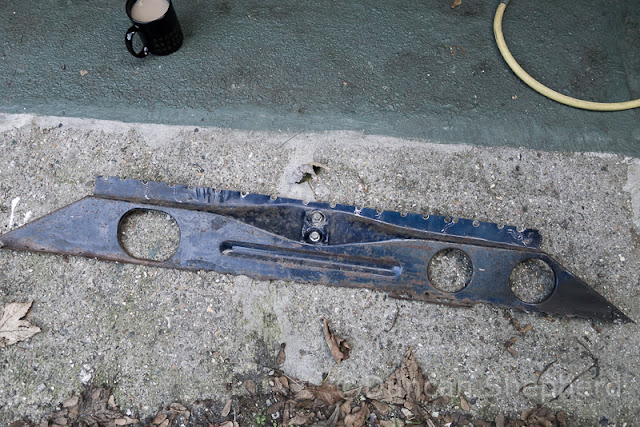As I suspect you are aware, issues with rot in the boot (trunk) of the Volvo 120 series are common and my Amazon is no exception. Over the years it has been 'repaired' a number of times and not always sympathetically.

I have made a start removing the filler and the patchwork of metal plates that make up the n/s and the floor next to the spare wheel well. I've ground off some of the welds, chiselled and bent back the non-original metal.
Incidentally, a word of warning. I had to remove a lot of seam sealer and I really should have been wearing gloves. A slip with the scraper brought the session to a rapid conclusion. I was lucky not to end up in A&E.
As I have already reported the lower rear quarter replacement panels are definitely not correctly positioned but I have successfully managed to uncover the original boot floor which although is in a very poor condition, does give me some points of reference for the rebuild.
Now that I have investigated more thoroughly, my repair panel budget might have to be revised. I was hoping to salvage the rear quarter sections as they are sound (i.e. not rusty), but I am not sure that I an going to be able to get them off intact and it also looks as if they are slightly misshapen towards the rear. New ones are available in two qualities, one being described as 'cheap repo', the other version suggested to be of better quality and fit, but at nearly twice the price. I'll reserve judgement until I've attempted to remove them.
Lower rear wing repair sections are a necessity though and now that I have also had a closer look repairing the existing spare wheel well is probably be more trouble than its worth. So I've added these to the shopping list, along with a bumper mount.
There are issues with both rear panels. The inner has rusted on the bottom edge and although a replacement is available at around £100, I am on a budget here. It may be feasible to repair it. The outer panel has rusted through at a number of points along the bottom edge but this is more challenging to fabricate. A new panel comes in at around £200 and at this stage I still have reservations about removing it.
I have totted up the cost of all these repair sections and the grand total is a shade over £600! More than I was hoping to spend, but I don't anticipate requiring any others for the rest of the vehicle. Realistically, if I can save either of the rear panels that will make a big difference to my budget and bring things in at a much more agreeable price. My plan is to attempt this before ordering any of the repair sections. If I succeed, then great, if not I will just have to bite the bullet and stomp up the extra cash.
With this is mind I have removed the inner panel using a Clarke spot weld drill kit, which worked a treat. I found with this tool I was able to separate the panels with little or no distortion. Maybe I'll do a demo/review at some point.
Looking at the outer panel from the inside, now that the inner piece is removed, I think that I am going to have to seriously consider replacing it.
Of course the real challenge is the boot floor itself. This I will have to fabricate as there are no replacement pressings available. I need to consider how I'm going to tackle that tricky looking recess that holds the fuel tank...






Comments
Post a Comment